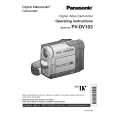|
|
|
Kategorie
|
|
Informacje
|
|
Polecamy
|
|
|
 |
|
|
Dla tego produktu nie napisano jeszcze recenzji!
 ;
jedyne do czego mogę mieć zastrzeżenie to jakość zdjęć zawartych w przesłanej instrukcji serwisowej ponieważ są fatalnej jakości, praktycznie nieczytelne. tak poza tym jestem zadowolony to jest to czego szukałem.
 ;
Wszystko w porządku.
Instrukcja czytelna i kompletna.
Dziękuję.
all right!
thank you.
 ;
Bardzo dobra instrukcja. Zawiera wszystko co potrzeba, polecam!
 ;
Instrukcja jest OK. Schematy czytelne, opisane niektóre procedury.
 ;
Instrukcja bardzo czytelna. zawiera co potrzeba. Polecam
CP830F Service Manual
The terms used in the schematic are described below; 1. AUTO represents a situation where the television has self-selected its picture source. This could be when the SCART SLOW SWITCHING pin has gone to a high state, and the AV 1 input is selected without the intervention of the user. 2. FORCED represents the change of source which has been commanded by the user (using the EXTERNAL button). The user always has priority, and can override the AUTO change of source by the television. 3. AV KEY represents the EXTERNAL button of the remote control, or on the television. 4. S/SW 1, or S/SW 2 represent the SLOW SWITCHING inputs of the first SCART (AV 1) or second SCART (AV 2), these each being pin number 8. 5. F/SW 1 represents the FAST SWITCHING input of the first SCART (AV 1), on pin number 16. The second SCART, AV 2, input does not possess a FAST SWITCHING input. The HIGH state of a slow switching input represents the request from the external source to be selected by the television. Whether this is accepted or not depends on the position in the logic diagram. The general rule is that the user always has priority, so the use of the AV KEY will always result in a defined logic path being followed. Under certain circumstances, defined in the diagram, the change of state of a slow switching input will result in the automatic change of source by the television. This change, such as the change from RF broadcast to the AV 1 input, can always be overridden by the user after the event. Each line on the diagram, with its associated text, represents the exact conditions under which the change of state will occur. Sometimes this will be accompanied by another action which will be automatically performed by the television, being to either ENABLE or DISABLE F/SW 1. 5.4.8 OVER CURRENT PROTECTION In case of overload, the SMPS secondary voltages will drop. The voltage on pin 18 of microcontroller drops below a reference voltage (x.xxV). The controlling software which continuously monitors this voltage will switch the set to stand by mode. To power on the set again the user must switch it off using the main power switch. Appropriate hysteresis guaranty a reliable operation. 5.5 TELETEXT DISPLAY National character option bits C12, C13, C14 are transmitted in the page header of a given teletext page. The national option bits are intended to change (or exchange) 13 characters within the G0 character set, according to the needs of each national language. These codes represent, for a given broadcaster, the intended language that the teletext page should be displayed in. As there are only 3 bits, there are only 8 codes available to cover all the possible language combinations. This means that for a received code there are several possibilities meanings, according to the local code of practice. This is not as bad as it first seems, as we use the user-selected OSD language to identify the intention of the broadcaster. For example, a user wishing to see Russian teletext should select Russian OSD language, otherwise he would not have correct teletext display on the TV. The table below allows the reader to understand the relationship between selected OSD language (which is under user control), the teletext language display (selected by national option bits in transmission page header) and the Packet 26 language selection (selected within packet 26 of the transmission page). An example: For Greek teletext display, (if national option code 1 1 1 is received from the broadcaster), the user should select the Greek OSD language. Even if English, French, German, Italian, Spanish, Dutch, Danish, Finnish, Norwegian
-58-
|
|
 |
> |
|

